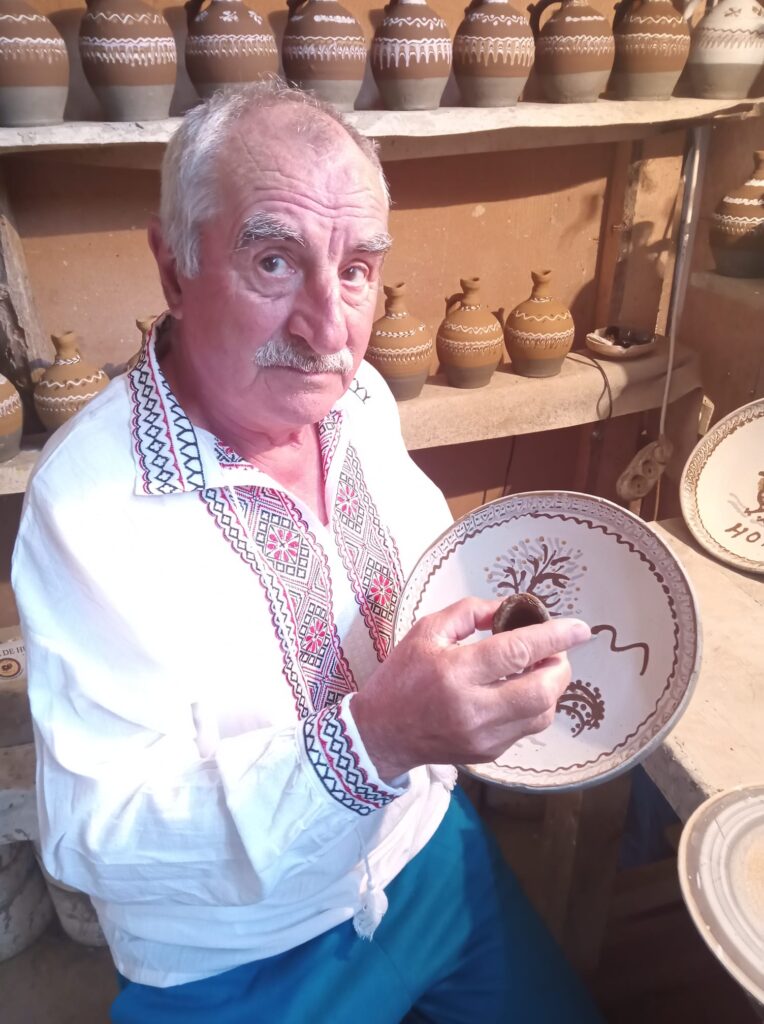
Am 76 de ani și am lucrat ceramică de când mă știu. De când m-am născut, asta am văzut în fața ochilor: ceramică. Olăria este o tradiție care s-a transmis în familia mea de-a lungul a trei generații, de la tată la fiu. Am participat la numeroase târguri, festivaluri și concursuri atât în țară, cât și în străinătate. Stilul meu de olărit păstrează o linie tradițională, iar culorile pe care le folosesc sunt trei din cele cinci existente. Obiectele sunt din argilă/pământ și sunt naturale. Am început să învăț meseria în anii ‘59 - ’60, când aveam 12-13 ani. Tatăl meu m-a învățat să lucrez cu grijă obiecte mici, precum căni și farfurii, pe care le decoram. În creațiile mele folosesc motive tradiționale, cum ar fi coada de păun. De asemenea, folosesc motive florale, cum ar fi bobocii de flori și frunzele. Există și un motiv de șarpe, pe care îl folosesc, alături de cocoș. Îmi place să experimentez cu motivele și să încerc lucruri noi. Îmi place să fac obiecte de uz casnic și gospodăresc. Și îmi place să fac ulcioare, pentru că reprezintă tradiția noastră. În vechime, oamenii luau ulciorul cu apă la muncă și apa era rece toată ziua.” Ce este și cum se realizează ulciorul? Este o piesă formată din patru componenete diferite care se pot asambla. Mai întâi, se realizează partea de sus, apoi partea de jos, care sunt asamblate separat. Apoi, se construiește corpul ulciorului, de face mânușa (toarta), apoi “țâța”, prin care se poate bea. Una din găurile sale este destinată adăugării apei, iar cealaltă este pentru a bea apa. De ce nu se bea apa prin aceeași gaură? Ei bine, aceasta este o tradiție și o alegere personală. Uneori, este mai bine să existe o deschidere mai largă pentru a permite introducerea mai rapidă a băuturii alcoolice, precum țuica, vinul sau rachiul. Dar, în general, gaura mai mică este destinată apei. Pentru tinerii care doresc să înceapă să practice olăritul sau pentru cei care sunt încă indeciși, aș spune că este o meserie frumoasă și plină de tradiție, autentică și cu valoare culturală. Astăzi, lucrul în olărie nu mai este greoi ca în trecut, datorită introducerii noilor utilaje și echipamente care fac procesul mult mai ușor. De exemplu, malaxatul pământului pregătit pentru modelare se realizează acum mult mai eficient. Iar oamenii se întorc la tradiții. Sper că v-am oferit o perspectivă interesantă asupra tradiției și a lucrărilor mele, vă mulțumesc și vă aștept la Horezu.
I am 76 years old and have worked in ceramics for as long as I can remember. Since I was born, this is what I saw before my eyes: ceramics. Pottery is a tradition that has been passed down in my family for three generations, from father to son. I have participated in many fairs, festivals and competitions both in the country and abroad. My pottery style keeps a traditional line and the colors I use are three of the five existing ones. The objects are made of clay/earth and are natural. I started learning the trade in the years '59 - '60, when I was 12-13 years old. My father taught me to carefully work small objects, such as cups and plates, which I decorated. In my creations I use traditional motifs such as the peacock tail. They also use floral motifs such as flower buds and leaves. There is also a snake motif, which I use alongside the rooster. I love experimenting with motifs and trying new things. I enjoy making household and household items. And I like to make jugs, because it represents our tradition. In the old days, people took the water jug to work and the water was cold all day. What is and how is the pitcher made? It is a piece consisting of four different components that can be assembled. First, the top is made, then the bottom, which are assembled separately. Then, the body of the jug is built, to make the glove (toarta), then the "breast", through which you can drink. One of its holes is for adding water and the other is for drinking water. Why not drink water through the same hole? Well, this is a tradition and a personal choice. Sometimes it is better to have a wider opening to allow the faster introduction of alcoholic drink such as plum brandy or wine. But generally the smaller hole is for water. For young people who want to start practicing pottery or for those who are still undecided, I would say that it is a beautiful craft full of tradition, authentic and with cultural value. Today, working in pottery is no longer as arduous as in the past, thanks to the introduction of new machines and equipment that make the process much easier. For example, the mixing of soil prepared for modeling is now done much more efficiently. And people return to traditions. I hope I have given you an interesting insight into the tradition and my works, thank you and I look forward to seeing you at Horezu.
New Educational Approaches for IT and Entrepreneurial Literacy of Senior Artisans

PROJECT:
2020-1-RO01-KA204-080350
New Educational Approaches for IT and Entrepreneurial Literacy of Senior Artisans

PROJECT:
2020-1-RO01-KA204-080350
The European Commission's support for the production of this publication does not constitute an endorsement of the contents, which reflect the views only of the authors, and the Commission cannot be held responsible for any use which may be made of the information contained therein.